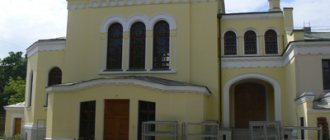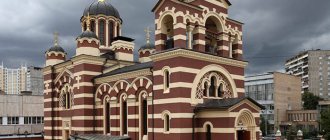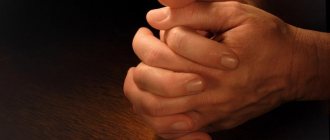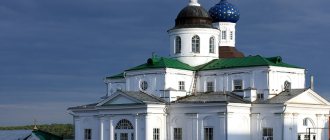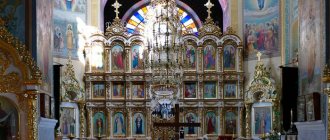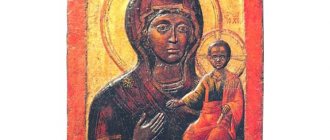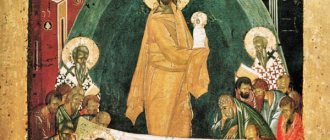The icon “Consolation in Sorrows and Sorrows” is known for numerous healings and has been revered by Orthodox Christians for a long time as miraculous. The annual feast of the Virgin Mary falls on November 19 (December 2). When performing divine services at this face, an akathist written for the religious painting “Quench My Sorrows” is used.
History of the icon
According to an ancient legend, the image of “Consolation in Sorrows and Sorrows” was originally owned by Patriarch Athanasius III of Constantinople. Thanks to this saint, the shrine was able to visit different countries, and in 1653 it was in Russia. In 1654, after the death of Athanasius III, the icon came to the Vatopedi Monastery, where one of the elders kept it.
The further history of the miraculous face was as follows:
- in 1849, the Metropolitan of Vatopedi monastery presented the relic as a gift to Vissarion, the former abbot of St. Andrew's monastery;
- in the summer of 1853, the image was sent to Odessa, and then to St. Petersburg to the theologian Theodoret, who in 1859 returned it to its previous location;
- in 1862, Abbot Vissarion, who was preparing to give his soul to God, handed over the shrine to the brethren.
Subsequently, the inhabitants of St. Andrew's Skete decided to send the miraculous image of the Mother of God to Russian soil for permanent storage. After this, the relic ended up in the Annunciation Cathedral in St. Petersburg. In 1929, the original painting was lost, and its current location remains unknown.
Description of the image
The icon “Consolation in Sorrows and Sorrows” looks like a folded composition, on the doors of which there are images of the Holy Great Martyr George the Victorious, St. Nicholas of Myra and other god-pleasers. In the central part of the picture there is the face of the Virgin Mary with the Child of God. The Queen of Heaven is depicted from the waist up, wearing embossed gilded vestments. The same rich clothes are worn by the Son of God. The Most Pure Mother of God points her palm at little Christ. The Savior makes a blessing gesture with one hand, and holds the scepter in the other.
At the bottom of the picture there are images of the holy righteous - Anthony the Great, Savva the Sanctified, St. Onuphrius, Euthymius the Great. On both sides of the Mother of God the figures of John the Baptist and John the Evangelist are painted. Above the image of the Virgin Mary, two angels are visible holding a royal crown above Her head. Six-winged Seraphim are depicted in the upper corners. On the religious painting you can read the inscription: “Image of the Most Holy Theotokos in sorrow and sorrow, Consolation.”
Miraculous image of the Queen of Heaven
Icon of the Most Holy Theotokos “Ekonomissa”
The miraculous icon is kept in the Great Lavra on Mount Athos. The Queen of Heaven is depicted sitting on a throne with the Infant Jesus. To the right of Her is the Venerable Confessor Michael, Bishop of Synad, and to the left is the Venerable Athanasius of Athos. In his hands is a symbolic image of the Lavra, which the Mother of God and Jesus herself bless with a priestly gesture.
St. Afanasy Afonsky
Saint Athanasius is the first organizer of monasticism on Mount Athos. Long before his appearance, hermits labored on the peninsula. However, Saint Athanasius was the first to found a communal monastery in this place, which is now called the Great Lavra. It is with the care of the monk for the arrangement of the monastery that the appearance of this icon is connected.
July 18 is the day of celebration of the memory of St. Athanasius of Athos, as well as the patronal feast of the Great Athonite Lavra.
Miracle of Our Lady
The holiness of Athanasius attracted many people who wanted monasticism. But the crop failure that occurred in those places, which caused a shortage of food, made it difficult to support the monks. When all the monks, unable to bear this poverty, left the Lavra, the saint, exhausted from hunger and despondency, prepared to move to another place.
Leaving the peninsula, he was exhausted and decided to rest. Suddenly he noticed a Woman, which made him very surprised, because even at that time women were forbidden to be here.
When the saint, at the command of the Mother of God, struck the stone with his staff, water flowed out of it. Returning back, Athanasius discovered that the monastery's storerooms, hitherto empty due to crop failure, were now miraculously filled with everything needed for food. Monks began to come to the Lavra again.
Interesting fact
On the site of this miraculous event, a temple was built, where to this day there is the same source revealed from the stone.
To this day, the Great Athos Lavra does not have a chief economist - a monk managing the monastic economy - only a sub-economist. Thus, according to the charter of the monastery, the Mother of God herself is Economissa.
"Hungry Nourisher"
Although, according to the Gospel, the main concerns of a Christian should be about finding the Kingdom of God, that is, about salvation, we should not forget that we are still in this temporary world, not devoid of worries and concerns. And if Saint Athanasius, the great ascetic and ascetic, was so exhausted by hunger that he was ready to leave the monastery he founded, and only the miracle of the Mother of God stopped him, then all the more so are we, far from his holiness, experiencing many everyday needs.
Therefore, before the image of Our Lady “Economissa”, many Orthodox Christians pray for home improvement, family well-being, as well as for any other need.
Mikhail Pankin
Miracles created
The icon showed a miracle for the first time in 1863. A memorable event took place in one of the women’s monasteries in the city of Slobodsky. Thanks to the help of the sacred image, a mute young man named Vladimir, who was studying at a theological school, was able to gain the gift of speech here. He suffered from illness for several years, as he was punished by heavenly forces for failure to fulfill his vow. Having said a prayer in front of the icon and venerated it, Vladimir received forgiveness and managed to speak on the same day.
After the inexplicable recovery of the mute young man, many more bright events occurred. Believers who turned to the Most Holy Theotokos for help through Her image “Consolation in Sorrows and Sorrows” received healing for paralysis, diseases of the arms and legs, and were delivered from demon possession.
In 1890, the icon was on its way to Russia from St. Andrew's Skete. There is information that along the way she performed a huge number of miracles and helped many adults and children. Through prayers to the shrine, residents of Rostov-on-Don, Moscow, Uglich, and Novocherkassk were healed.
Saint Barbara: life
Holy Martyr Barbara. Icon
The Holy Great Martyr Barbara is the same age as many martyrs and martyrs. This was a period of persecution of the Church, and that time gave our history such martyrs and martyrs as Varvara, Catherine, Paraskeva, Anastasia, Panteleimon, George, Demetrius and hundreds of thousands of believers who suffered not only in the Roman Empire, but suffered in Antioch, Alexandria and in other places, with which they glorified their life with a feat.
Barbara was born into the family of the pagan Dioscorus, who was a very noble and wealthy man in the city of Iliopolis in Phoenicia (modern-day Lebanon). Her mother died when Varvara was still little, and raising her daughter fell entirely on the shoulders of her father, who, wanting to hide his daughter from prying eyes, built a tower where, besides Varvara, there were only her pagan teachers and servants.
From the tower there was a beautiful view of mountains, rivers, and plains covered with flowers. And the girl, contemplating this world, gradually came to know the True Creator. She began to ask herself the question, who could create such beauty? Who is the Creator of the Universe? Gradually she came to the idea that paganism was soulless idols that could not arrange the world around them in such a way. And she wanted to know more about it.
Meanwhile, despite her imprisonment, rumors of Varvara’s extraordinary beauty spread throughout the city. And the most noble suitors asked for her hand. And just as her father did not ask her to accept the proposal and get married, she refused the marriage and warned that if they insisted, such persistence could end tragically.
We advise you to study the Sacrament of the Priesthood (ordination)
The father, fearing that his daughter’s character had changed due to her secluded life, allowed her to leave the tower periodically and choose friends for herself. And Varvara met her peers in the city, who were Christians and told her about faith in Christ and His saving power. She was kindled with all her heart when she heard the answers to the questions that she had repeatedly asked herself, and she wished to accept the Sacrament of Baptism.
After some time, a priest came to Iliopol under the guise of a merchant, who performed the Sacrament of Baptism.
At that time, a bathhouse with two windows was built at her father’s house, but on the advice of Varvara, as described in the canon, in the akathist, a tower with three windows was built. Testimony in honor of the Trinity - the trinitarian light from heaven, which sanctifies every soul. Above the entrance she inscribed a Cross, which was firmly imprinted on the stone. “And according to legend, where she stood on the threshold there was still raw material that froze, leaving a trace of her foot, from which a spring of living water flowed, which to this day has great healing power,” said Metropolitan Pavel.
In Raphael's famous painting The Sistine Madonna, Saint Barbara is depicted to the right of the Virgin and Child.
When the father arrived from a business trip, he was dissatisfied with the violation of the construction plan, and his daughter told him about the saving power of the Lord and the Triune God, that she recognizes only one God - the crucified Christ. He burned with hatred and anger.
At first he tried to dissuade her with admonitions and gifts. But she did not accept all this, because she accepted the Heavenly Bridegroom with all her heart. Then the father grabbed the sword to hit her, but she ran away, and the father rushed after her. A mountain blocked her path, but it parted and hid her in a crevasse. And she took refuge in one of the caves. For a long time the father could not find his daughter, but the shepherds indicated the place where she was. He found her, severely beat her, took her into custody, and starved her to death. Then he handed it over to the ruler of the city, Martian.
She was brutally tortured, scourged, and fresh and deep wounds were rubbed with hair shirt (a coarse fabric made from goat hair). And at night in prison, where the saint prayed to the Lord Jesus, the Savior Himself appeared to her and healed her wounds.
The next day, Saint Barbara was subjected to even more sophisticated torture. The Christian Juliana, standing in the crowd, was filled with sympathy for the suffering of this beautiful and rich girl and also wanted to suffer for Christ, beginning to loudly condemn the tormentors. They grabbed her too.
They were tortured for a long time: they tore their bodies with hooks, cut off their skin, and led them naked around the city with beatings and abuse. But, through the prayers of the saint, the Angel of the Lord covered the body of the martyrs with radiant clothing. After much torment, the martyrs were beheaded. Varvara was executed by her father. “It should be noted that soon God’s retribution befell both Dioscorus and Martian - they were burned by lightning,” noted Bishop Paul.
During the execution of Saint Barbara, blood and milk flowed from her body and vessels - evidence that the holiness of life always has superiority over all the events that happened.
Famous lists
Initially, several lists of relics were kept in the Vyatka province. The first copy of the painting was created in 1863. Its author was Vladimir Nevolin, who was the same young man who received healing from muteness. The work was placed for storage in the Vyatka Nativity of Christ Monastery and decorated with a precious robe brought from Athos. A year later, Nevolin made a second list, given to the Cathedral of St. Nicholas in the city of Nolinsk.
In 1882, construction began on the cathedral in honor of the icon of the Mother of God “Consolation in Sorrows and Sorrows,” initiated by the abbess of the Transfiguration Cathedral from Vyatka. Here was a miraculous list that previously belonged to Hieromonk Paisius. In the Vyatka province, this icon regularly participated in religious processions, during which amazing miracles invariably occurred.
In Russia there were several more famous lists of Orthodox shrines. These include an icon painted by the masters of St. Andrew's monastery, placed in 1917 in the St. Sophia Cathedral of Tsarskoe Selo. In 1939, this temple was blown up, and most of the icons stored in it were burned. The image of the Mother of God was miraculously preserved. In 1995, he ended up in the St. Sophia Cathedral in St. Petersburg, and in 2012 he returned to the Tsarskoye Selo Cathedral, located on Cathedral Square. Other copies of the painting, known for their miraculous abilities and myrrh-streaming, are located in the St. Nicholas Cathedral in St. Petersburg, in the Voronezh Alekseevo-Akatova convent.
Strict Orthodox holidays
Despite the fact that the modern church has become more lenient and people are allowed to treat prohibitions less strictly, many superstitions and signs associated with Orthodox celebrations are still preserved among the people and are strictly observed.
There are a number of certain prohibitions on each church holiday. It is believed that compliance with all strictures will protect against failure, and God will forgive sins and be favorable and hear all prayers.
Celebrations with a moving date
The main Orthodox holiday is Easter, which is celebrated every year at different times. It is from this holiday that Palm Sunday, the Ascension of the Lord and the Day of the Holy Trinity are counted.
- A week before the Easter celebration, Palm Sunday is celebrated, a holiday associated with the arrival of Jesus in the holy city.
- 40 days after Easter, the Ascension of the Lord is celebrated - when Jesus appeared to his father.
- 50 days after the main celebration, Trinity is celebrated - when the holy spirit descended on the apostles.
We advise you to study What is Golgotha and where is it located?
Before Easter, a strict fast is observed, which lasts 40 days. The strictest are the 2 days before Easter (Good Friday and Saturday), during which time it is forbidden to work, cook, clean or wash unless absolutely necessary.
Basic prohibitions:
- You cannot be stingy and greedy, you need to help the poor and needy.
- It is forbidden to swear, be sad, or get angry.
- Overeating and excessive alcohol consumption are prohibited.
- You cannot go to a cemetery and mourn the dead.
- Intimacy is prohibited.
Easter eggs and Easter cakes should not be thrown away. The surplus is given to the poor or taken to the cemetery.
When are the holidays in 2022?
The Orthodox calendar contains all the main holidays that believers will celebrate in 2022. Transitional dates are highlighted in bold.
Great holidays:
- April 28 - Easter;
- January 7 - Nativity of Christ;
- January 19 - Epiphany (Holy Epiphany);
- February 15 - Presentation of the Lord; April 7 - Annunciation of the Blessed Virgin Mary;
- April 21 - Palm Sunday (Entry of the Lord into Jerusalem);
- June 6 - Ascension of the Lord;
- June 16 - Holy Trinity Day (Pentecost);
- August 28 - Assumption of the Blessed Virgin Mary;
- September 21 - Nativity of the Blessed Virgin Mary;
- December 4 ‒ Presentation of the Blessed Virgin Mary into the Temple
Non-Twelfths;
- July 12 - Holy Apostles Peter and Paul;
- October 14 - Intercession of the Blessed Virgin Mary.
Each holiday has its own characteristics, but they are all connected by the fact that on these days it is customary to relax physically and spiritually, and not to work or take care of everyday life.
What prayers are read at the icon?
The icon “Consolation in Sorrows and Sorrows” is considered by Christians to be a faithful helper, thanks to which it is possible to restore lost health and return to a full life. Believers turn to her with prayers for a wide variety of ailments:
- paralysis;
- muteness;
- tongue-tied;
- diseases of the limbs;
- headaches;
- seizures;
- nervous disorders.
The image of the Queen of Heaven helps to get rid of demonic possession, alcohol, nicotine, and drug addiction. Thanks to prayers in front of this shrine, one can resolve difficult situations, cleanse the soul of negativity and strengthen one’s faith.
You can pray at the icon in church or at home. You should approach the Mother of God with pure thoughts, in a peaceful state. The clergy say that this can be done with the help of special prayers or in your own words. Many turn to the image on the day of its celebration, but the Virgin Mary hears those praying on other days as well. The main thing is that the request to the Mother of God is pure and comes from the depths of the heart.

